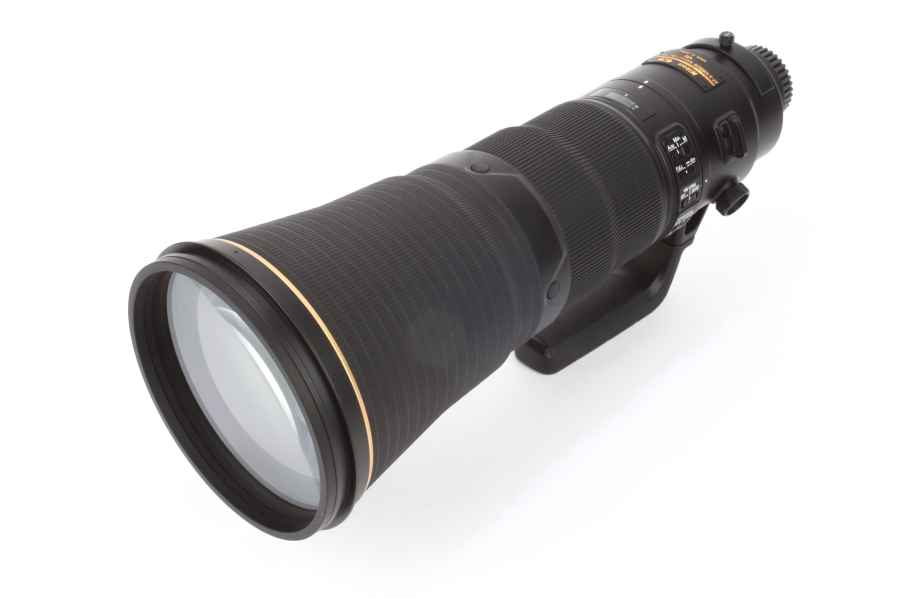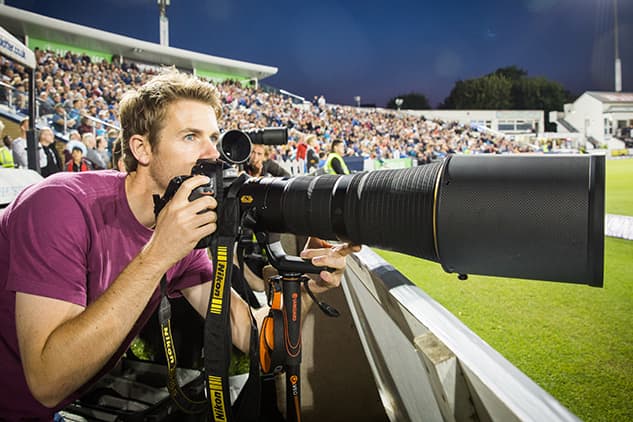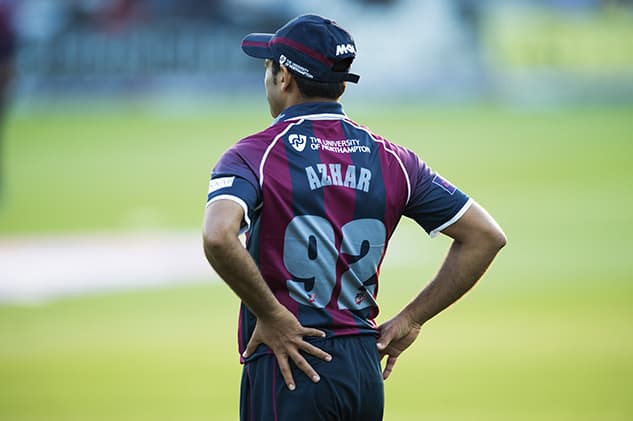I like to think of photography as a relaxing and enjoyable pursuit, but right now I’m frustrated and livid about the prospect of having to cancel today’s shoot. Early this morning I was expecting to take delivery of the almighty AF-S NIKKOR 600mm f/4E FL ED VR and Nikon D4s, but to my dismay it hasn’t arrived and time is running out – in a few hours I’m supposed to be setting up ready to shoot the quarterfinals of the NatWest T20 Blast cricket competition. I then breathe a huge sigh of relief as I get a call from the courier telling me its just arrived. After dashing to the post room in happier spirits, I break the lens out of its custom-fit carry case and mount it to the D4s – finally I’m good to go, or at least you’d think. Turning the D4s on reveals a blinking battery symbol on the top-plate indicating there’s no charge in the camera whatsoever. Today is clearly not my day.
As I sprint to Waterloo to catch my train with £14,000 worth of camera kit slung over my shoulder, the sheer mass of the lens (all 3,810g of it) is starting to take its toll. I quickly find myself having to revert to carrying the heavy combination upside down by the built-in rotating tripod collar. It’s at this moment I’m thankful for the rubberised grip on the underside of the collar handle that makes it feel like its glued to my hand, and for a bit of extra security I wrap the lens strap around my wrist a few times to ensure that if anyone does decide to steal it from me, I’m going with it.
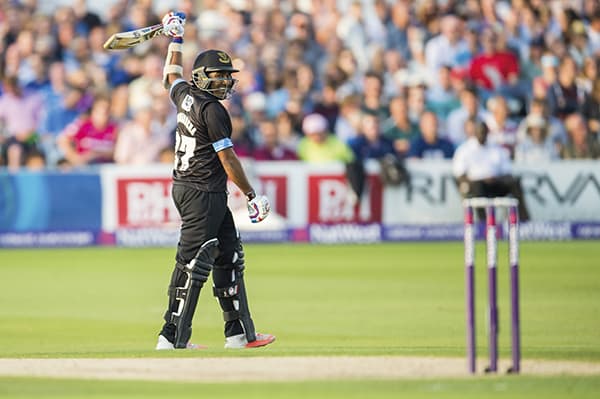
Mahela Jayawardene raises his bat to celebrate his half century for Sussex in their T20 clash with Northamptonshire
Mercifully, I find a mains socket on the train to get some power into the D4s battery and as I set off, first to Tonbridge to collect my car and then onwards to Brighton, I take time to get up to speed with some of the key features on the lens by taking a look at the user manual. I’m eager to try out its focus function buttons located mid-way down the barrel, the memory recall function as well as the sport vibration reduction mode.
After what can only be described as a frantic journey, I arrive at the Sussex Cricket County Ground five minutes late and pick up my press pass before setting up beside six other press photographers who all happen to be shooting with a Nikon. As I screw my trusty Vanguard monopod into the tripod collar and raise the camera to the action, I become aware of the photographers to the left and right of me glancing at my setup. ‘Is that what I think it is?’ one jealous press photographer asks to which I answer, ‘If it’s Nikon’s latest 600mm you’re thinking of, you’re right.’ With no time to chat, I’m straight to work and having had no time to setup the D4s beforehand I find myself customising it in-between shots.

The late evening sun glints on the barrel of the Nikon AF-S NIKKOR 600mm f/4E FL ED VR during an interval
Camera set up, it’s time to turn my attention to the lens and I begin by flicking the focus mode to Autofocus with manual override (A/M). This is rather similar to the lens’s M/A mode, with the exception that it requires the focus ring to be rotated further before auto-focus is overridden. My main reason for choosing A/M ahead of M/A however is that it can prevent accidental changes to focus caused by unintended operation of the focus ring. As I compose my first few shots and instinctively depress the shutter halfway, the lens refuses to focus. The first thought that comes into my mind is that I’ve been sent a faulty sample, but to my relief it instantly finds focus as soon as I press one of the function buttons on the barrel. A moment later I head into the D4s menu where I notice the AF activation is already set to AF-ON, which I keep it set to. This will allow me to use the back-button focus method to prevent the risk of players in the foreground throwing the lens out of focus as they pass in front of the lens – something that can also be achieved on the lens itself by depressing and holding one of the four focus function buttons. Taking a closer look at the focus function switch, I notice that it can also be pushed forward from its current AF-ON setting to enter AF-L mode, which is used to lock the autofocus position of the lens and disable the focus function buttons from operating.
A quick review of my first set of images reveals that the lens is allowing me to shoot extremely close to the action and I’m amazed that just a couple of pushes of the magnify button in playback mode are all that are needed to fill the screen with the batsman at the farthest end of the ground. Another quick glance at the side of the lens indicates I have the vibration reduction (VR) switch set to Normal, which is designed to be effective when shooting stationary subjects. Though I haven’t detected any signs of camera shake in my shots, something I’ve looked to avoid by supporting the lens on a monopod and shooting at 1/800sec, I switch the VR mode over to Sport, which is designed to be more effective for subjects that move rapidly or unpredictably. A quick referral to the manual confirms that both Normal and Sport modes can be used when a camera is mounted on a monopod with no ill effects. Though it’s hard to trace in such a loud environment a low frequency whirring noise can be detected when the VR is used in quieter surroundings.
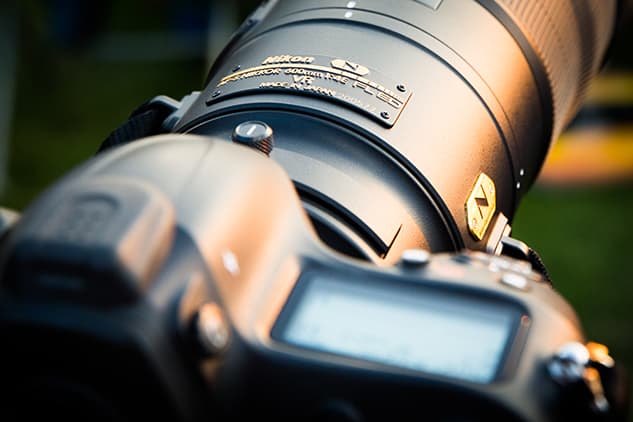
The lens accepts 40.5mm filters, which are loaded via a drop-in filter plate on the top of the barrel
With the huge carbon-fibre lens hood attached, the lens protrudes 620mm from the lens mount. As I sling it over my shoulder in search of a new location to shoot from I find myself having to ignore some heckling from cricket fans insinuating it’s not all about size. On the opposite side of the ground the last rays of sun give way to the floodlights and as I push the sensitivity beyond ISO 1000 to ensure my shutter speed doesn’t fall below 1/800sec, I find myself experimenting with the lens’s memory recall function. Ensuring the beep on/off switch is enabled and the focus mode switch is set to its central memory recall setting, I use the AF-ON button on the camera to obtain focus on the batsman before depressing the memory set button located on the opposite side of the barrel. A beep sounds indicating the lens has stored the focus distance and as I pan to my right to capture a quick shot of a catch, I’m able to reacquire the same focus distance I used in my previous shots in an instant with a press of a focus function button. It’s a feature that’s particularly useful and it can be performed in any focus mode regardless of the position of the focus mode switch.
At the interval between innings I can’t resist loading up a few shots on my MacBook to examine how well the lens is performing and check I’m satisfied with my results.
An inspection in Lightroom reveals absolutely sensational sharpness in the centre of the frame complemented by an attractive depth of field at its maximum aperture. Being a sports and wildlife lens where speed is everything it’ll undoubtedly see most use wide-open. Vignetting in the corners at f/4 isn’t offensive either, offering reassurance that I can happily use it at its maximum aperture for the remainder of the evening.
As I retreat to the press area, a few huge hits from a Northants batsman has me setting the lens quickly once more. Already attached to the monopod, I loosen off the tripod collar ring attachment screw and rotate the body through 90 degrees to capture a few shots in the portrait orientation. Unlike some collars that notch into place at 90 degrees this one doesn’t, so I find myself pulling my eye away from the viewfinder for a split second to line up the white dots on the lens and the collar as a guide. The last of the ambient light has now disappeared and with dark clouds looming I have no choice but to raise the sensitivity once more to ISO 3200 in an attempt to freeze the action. The light levels are now much more challenging than when I first arrived, but the lens is continuing to lock-on and find focus instantly. It performed exceptionally well in such a low light and challenging sporting environment.
With the result of the cricket a foregone conclusion, I finish by loosening off my monopod that’s been attached all evening to find out what it’s like to use handheld. A few curious looks and three minutes later I find myself resting the combination nose down on the hood to give my arms a break. There’s no denying the 1,250g it sheds from its predecessor makes a huge difference when it’s being carried around, but for everyday use it’s a lens that has to be paired up with a monopod to take the weight off.
Nikon AF-S NIKKOR 600mm f/4E FL ED VR Field Test – Verdict
As I loosen off the lens hood screw, inverse the hood and protect the absolutely huge front element with the slip-on front lens cap I take some time to reflect on today’s experience. The AF-S Nikkor 600mm f/4E FL ED VR is up there as one of the most expensive lenses I’ve ever used and to be honest I don’t think I’ll lay hands on a telephoto lens much better. I’m in awe of its sharpness and the results it produces, the only regret I have is not packing a Nikon APS-C DSLR in my bag to test it with, which would have offered an even longer focal length equivalent to 900mm.
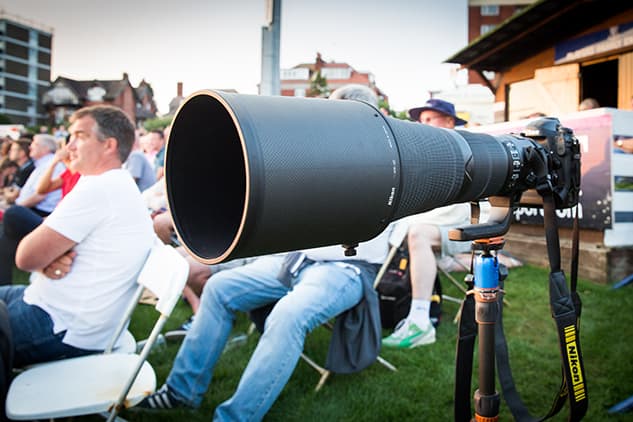
The sheer size of the Nikon AF-S NIKKOR 600mm f/4E FL ED VR dwarfs the Nikon D4s that it was tested with
Although its price implies it’ll only ever find its way into the hands of a working pro specialising in sports or wildlife, some lens hire companies have already added it to their books with Fixation charging £90 a day or £355 to hire it for a week. There’s the small matter of having to put down a £7,500 deposit that will be fully refunded upon its safe return, but for those on a specialist assignment or a lifetime trip away it’s good to know you can get your hands on it for a fraction of cost you’d pay for it outright.
It’s not often I say this, but I feel privileged to have used the AF-S Nikkor 600mm f/4E FL ED VR. It’s a spectacular piece of glass that I am sad to be sending back.
To view more images taken using the AF-S Nikkor 600mm f/4E FL ED VR at Eastbourne air show, check out our sample image gallery.
Amateur Photographer would like to express thanks to Sussex County Cricket Club for allowing us to shoot at the County Ground in Hove.

